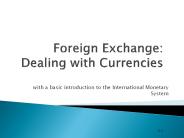Foreign Direct Investment in US Transportation Infrastructure
1 / 23
Title:
Foreign Direct Investment in US Transportation Infrastructure
Description:
Foreign Direct Investment in US Transportation Infrastructure Eva Lerner-Lam, President Palisades Consulting Group, Inc. and Palisades China Group, LLC – PowerPoint PPT presentation
Number of Views:31
Avg rating:3.0/5.0
Title: Foreign Direct Investment in US Transportation Infrastructure
1
Foreign Direct Investment in US Transportation
Infrastructure
- Eva Lerner-Lam, President
- Palisades Consulting Group, Inc. and Palisades
China Group, LLC - Presented at the 2011 ASCE Annual Conference
- Beyond Financial Engineering
- Building, Operating, and Maintaining
Transportation Infrastructure - Memphis, TN
- October 22, 2011
2
Outline
- Recent History of Foreign Direct Investment in
Transportation Infrastructure in the US - Current Situation Disappointing
- Reasons for Disappointment
- What is the US Public Looking for?
- Who Are Foreign Investors?
- BRIC Sovereign Wealth Funds are the New Global
Investors - What Foreign Investors Look For
- Opportunities and Challenges
- Priming the Pump
- In Summary
3
Recent History of Foreign Direct Investment in
the US
- In a 2009 study1, NJ PIRG concluded that
- Toll road privatization is becoming increasingly
prevalent in the United States - Between 1994 and early 2006, 21 billion was paid
for 43 highway facilities in the US - By the end of 2008, 15 roads had been privatized
in 10 different states - Currently, approximately 79 roads in 25 states
are under consideration for some form of
privatization. - 1http//cdn.publicinterestnetwork.org/assets/H5Ql0
NcoPVeVJwymwlURRw/Private-Roads-Public-Costs.pdf
4
Current Situation Disappointing
- Severe public finance constraints on maintenance
and upgrading of transportation infrastructure
made up-front cash payments from private
investors seem attractive - However, many privately-funded projects are not
performing well financially, creating major
uncertainties for investors, public agencies and
taxpayers
5
Reasons for Disappointment
- Traffic projections were greatly overestimated
- Compensation and non-compete terms in
privatization agreements guaranteed returns to
investors at taxpayer expense - Agreements distorted public policy
decision-making for emergency, traffic and
environmental management
6
What is the US Public Looking For?
- Control over regional decisions about
transportation planning and management - Fair value so future toll revenues wont be sold
off at a discount - Deals that do not last longer than the uselife of
an asset - State-of-the art maintenance and safety standards
instead of statewide minimums - Transparency to ensure proper public vetting of
privatization proposals - Full accountability in which the legislature must
approve the terms of a final deal, not just
approve that a deal be negotiated. - NJPIRG Education Fund (Spring 2009)
7
What is the US Public Looking For?
Knowledgeable and accountable technical and
political leadership
8
Who Are Foreign Investors?
- Sovereign Wealth Funds from the Middle East,
Europe and Asia (In 2010, SWFs from the Middle
East held 44 of all SWF assets under
management2). - Today, the BRIC SWEs have rapidly growing
foreign exchange accounts and foreign asset
holdingsthey are the new kid on the block - Taken together, SWFs represent trillions in
available funds for US infrastructure (foreign
assets under management of SWFs could reach
US610 trillion by 20133 - 2Rebuilding America The Role of Foreign Capital
and Global Public Investors, Brookings Institute,
March 2011 - 3Sovereign Wealth Fund Institute,
http//www.swfinstitute.org/research/imfswfreport.
pdf
9
BRIC Sovereign Wealth Funds are the New Global
Investors
10
BRIC Sovereign Wealth Funds are the New Global
Investors
11
What Did Foreign Investors Look For?
- Pre-2008, SWFs looked for
- 20-30 returns
- Such high returns required complex, opaque
agreements involving accelerated depreciation tax
benefits, taxpayer guarantees of stabilized
revenues, non-compete restrictions that limit
public sector management of emergencies, traffic
and the environment
12
What are Foreign Investors Looking for in a
Post-2008 World?
- Todays SWFs are looking for
- In general Long-term investment horizons,
capital preservation, asset diversification,
predictable returns, and the mitigation of
political risk - For transportation infrastructure projects
Transparent, project-finance deals (passive
minority equity and bond investments)
13
What are Foreign Investors Looking for in a
Post-2008 World?
- With global economic crises continuing unabated,
most SWFs are now seeking more traditional,
conservative places to put cash - Private Activity Bonds (PABs) are increasing in
popularity - Timing may be right for civil infrastructure
investments by SWFs
14
Our Projects, Their Cash
US Infrastructure Projects
Sovereign Wealth Funds Cash
?
highest and best use
15
Our Projects, Their Cash
highest and best use
Sovereign Wealth Funds Cash
US Infrastructure Projects
16
Our Projects, Their Cash
highest and best use
Sovereign Wealth Funds Cash
US Infrastructure Projects
17
Opportunities and Challenges
- Opportunities New era of infrastructure needs
and available cash from SWFs - Challenges Understanding the economic,
financial and political motivations for foreign
investment by SWFs
18
Priming the Pump
- Evolve a dynamic twenty-first century policy
architecture (Brookings Institute, March 2011) - Encourage a Global Public Investors Roundtable
(Ibid)
19
Priming the Pump
- Civil Engineers Engage, and demand a seat at
that Roundtable
20
Priming the Pump
Knowledgeable and accountable technical and
political leadership
21
In Summary
- Americas infrastructure funding needs are great
- Post-2008 financial conditions are changing the
landscape in private sector infrastructure
investing - Sovereign Wealth Funds owned by BRICs are growing
substantially they are new, and want to engage - We (as a nation, and as a profession) should move
slowly, but deliberately, toward engagement
directly with SWFs
22
References
- Crumbling Infrastructure, Crumbling Democracy
Infrastructure Privatization Contracts and Their
Effects on State and Local Governance, Ellen
Dannin. - http//www.law.northwestern.edu/journals/njlsp/v6/
n1/2/2Dannin.pdf - BRIC Sovereign Wealth Funds The External Wealth
of Governments, Deutsche Bank, September 24,
2010. - https//www.dws-investments.com/EN/docs/research/B
RICsovwealthfunds.pdf - Private Roads, Public Costs The Facts About
Toll Road Privatization and How to Protect the
Public, Phineas Baxandall, Ph.D., U.S. PIRG
Education Fund, Spring 2009. - http//cdn.publicinterestnetwork.org/assets/H5Ql0N
coPVeVJwymwlURRw/Private-Roads-Public-Costs.pdf - Privatization and the Sale of Tax Revenues, Julie
A. Roin. - http//www.minnesotalawreview.org/wp-content/uploa
ds/2011/06/Roin_PDF.pdf - Rebuilding America The Role of Foreign Capital
and Global Public Investors, Monday, October 17,
2011. - http//www.brookings.edu/papers/2011/0311_sovereig
n_wealth_funds.aspx
23
Thank You!































